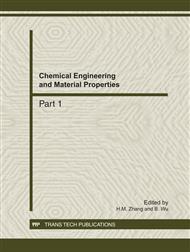[1]
W.C. Xue, A. Bandyopadhyay, S. Bose. Mesoporous calcium silicate for controlled release of bovine serum albumin protein. Acta Biomater Vol 5 (2009), p.1686–1696.
DOI: 10.1016/j.actbio.2009.01.012
Google Scholar
[2]
S. Xu, K. Lin, Z. Wang, J. Chang, L. Wang, J. Lu. Recon- struction of calvarial defect of rabbits using porous calcium silicate bioactive ceramics. Biomaterials Vol 29 (2008), p.2588–2596.
DOI: 10.1016/j.biomaterials.2008.03.013
Google Scholar
[3]
J. Buehler, P. Chappuis, J.L. Saffar, Y. Tsouderos, A. Vignery. Strontium ranelate inhibits bone resorption while maintaining bone formation in alveolar bone in monkeys (Macaca fascicularis). Bone, Vol 29 (2001), p.176–179.
DOI: 10.1016/s8756-3282(01)00484-7
Google Scholar
[4]
Z.Y. Li, W.W. Lu, P.K.Y. Chiu, W.M. Lam, B. Xu, K. M. C. Cheung, J. C. Y. Leong, K. D. K. Luk. Strontium-calcium coadminis- tration stimulates bone matrix osteogenic factor expression and new bone formation in a large animal model. J. Orthop. Res. Vol 27 (2010).
DOI: 10.1002/jor.20818
Google Scholar
[5]
S. Peng, G. Zhou, K. D. K. Luk, K. M. C. Cheung, Z. Y. Li, W. M. Lam, Z. Zhou, W. W. Lu. Strontium promotes osteogenic differentiation of mesenchymal stem cells through the Ras/MAPK signaling pathway. Cell. Physiol. Biochem. Vol 23(2009).
DOI: 10.1159/000204105
Google Scholar
[6]
J. Y. Reginster. Strontium ranelate in the therapeutic strategies for osteoporosis, including GIO. Bone Vol 45(2009), p. S131.
DOI: 10.1016/j.bone.2009.07.042
Google Scholar
[7]
N. A. T. Hamdy. Strontium ranelate improves bone micro architecture in osteoporosis. Rheumatology Vol 48 (2009), p. Iv9–Iv13.
DOI: 10.1093/rheumatology/kep274
Google Scholar
[8]
B. Habermann, K. Kafchitsas, G. Olender, P. Augat, A. Kurth. Strontium ranelate enhances callus strength more than PTH 1-34 in an osteoporotic rat model of fracture healing. Calcif. Tissue Int. Vol 86 (2010), p.82–89.
DOI: 10.1007/s00223-009-9317-8
Google Scholar
[9]
C.T. Wu, Y. Ramaswamy, D. Kwik, H. Zreiqat. The effect of strontium incorporation into CaSiO3 ceramics on their physical and biological properties. Biomaterials Vol 28 (2007), p.3171–3181.
DOI: 10.1016/j.biomaterials.2007.04.002
Google Scholar
[10]
L. L. Hench, J.M. Polak. Third-generation biomedical materials. Science 2002, Vol 295 (2002), p.1014–1017.
DOI: 10.1126/science.1067404
Google Scholar
[11]
W. Zhang, Y. Shen , H. Pan, K. Lin, X. Liu, B.W. Darvell, W.W. Lu, J. Chang, L. Deng, D. Wang, W. Huang. Effects of strontium in modified biomaterials. Acta Biomater. Vol 7(2011), pp.800-888.
DOI: 10.1016/j.actbio.2010.08.031
Google Scholar


